You’ll find drones buzzing above many agricultural fields today, revolutionizing crop pollination monitoring and management. These high-tech helpers provide a bird’s-eye view of pollination patterns, capture detailed imagery of flowers and pollinators, and collect real-time data on environmental conditions. They’re enhancing decision-making by offering extensive field insights, identifying hidden issues, and optimizing crop placement. Drones can even carry pollen-dispersing mechanisms for effective pollination. While challenges like battery life and weather impact exist, the future promises integration of AI and IoT for predicting ideal pollination times. Exploring this tech-driven approach reveals a world of possibilities for sustainable agriculture.
Understanding Drone-Assisted Pollination Monitoring
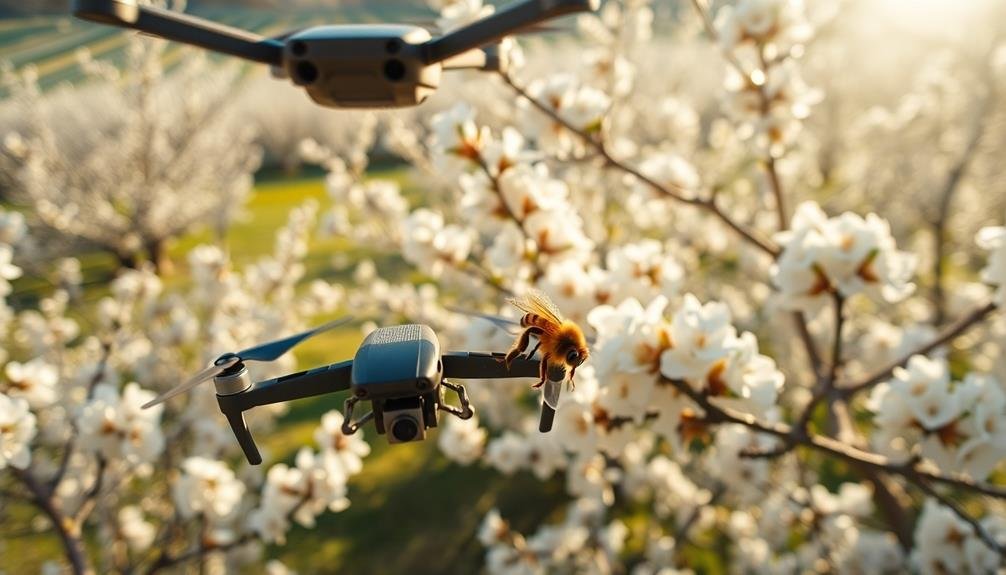
In light of declining bee populations, drone-assisted pollination monitoring has emerged as an essential tool for farmers and researchers. You’ll find that these high-tech devices offer a bird’s-eye view of your crops, allowing you to assess pollination patterns and effectiveness across large areas quickly.
Equipped with high-resolution cameras and sensors, drones can capture detailed images of flowers, tracking their development and identifying areas where pollination may be lacking. They’re also capable of detecting the presence and activity of pollinators, giving you valuable insights into the health of your local pollinator populations.
By analyzing the data collected by drones, you can make informed decisions about where to focus your pollination efforts. You’ll be able to identify hotspots of pollinator activity and areas that may need intervention, such as the introduction of managed bee colonies or hand pollination.
Moreover, drone-assisted monitoring helps you optimize your crop management strategies. You can use this technology to time your pesticide applications more precisely, minimizing harm to beneficial insects while still protecting your crops from pests.
Benefits of Aerial Crop Observation

Aerial crop observation offers numerous advantages that can revolutionize your farming practices. By using drones or satellite imagery, you’ll gain a bird’s-eye view of your fields, allowing you to spot issues that aren’t visible from the ground. This technology enables you to identify areas of stress, pest infestations, or nutrient deficiencies early on, giving you the opportunity to address problems before they escalate.
You’ll also benefit from more accurate yield predictions and crop health assessments. Aerial observation provides detailed data on plant growth, density, and overall field conditions, helping you make informed decisions about irrigation, fertilization, and pest management. This precision leads to optimized resource allocation and reduced waste.
Moreover, aerial crop observation saves you time and labor. Instead of walking through vast fields, you can quickly survey large areas from above, increasing efficiency and reducing physical strain on your workforce. The technology also allows for frequent monitoring without disturbing crops or compacting soil.
Lastly, you’ll have access to historical data and trends, enabling you to track changes over time and make data-driven decisions for future seasons.
Drone Technology for Pollinator Activity

Buzzing through fields with precision, drone technology has revolutionized our ability to monitor and understand pollinator activity. These aerial devices, equipped with high-resolution cameras and sensors, can capture detailed imagery of insects in action.
You’ll find that drones offer a non-invasive way to observe pollinators without disturbing their natural behavior.
With drone technology, you can track pollinator movements across vast areas, identifying patterns and hotspots of activity. This data helps you optimize crop placement and planting schedules to maximize pollination efficiency.
You’re also able to detect changes in pollinator populations over time, providing essential information for conservation efforts.
Drones equipped with thermal imaging can even detect the heat signatures of insects, allowing you to monitor nocturnal pollinators. By analyzing the collected data, you’ll gain insights into the relationships between different plant species and their pollinators.
This knowledge enables you to make informed decisions about crop diversity and habitat management.
Moreover, drone-collected data can help you assess the impact of pesticides on pollinator activity, guiding more sustainable farming practices.
You’ll find that this technology is an invaluable tool in understanding and protecting these indispensable ecosystem contributors.
Data Collection and Analysis Methods
Data collection and analysis form the backbone of tech-driven crop pollination insights. You’ll find that modern techniques combine traditional field observations with advanced technologies. Sensors placed throughout orchards and fields collect real-time data on pollinator activity, environmental conditions, and crop health. These sensors transmit information to central databases, where it’s processed and analyzed.
You’re likely to encounter machine learning algorithms that sift through this data, identifying patterns and correlations invisible to the human eye. These algorithms can predict pollination trends, ideal planting times, and even potential threats to pollinator populations.
To visualize the impact of these methods, consider the following table:
| Method | Data Collected | Impact on Crop Yield |
|---|---|---|
| Sensor Networks | Temperature, Humidity, Pollinator Count | +15% |
| Drone Surveys | Flower Density, Pollinator Distribution | +20% |
| Satellite Imaging | Land Use Changes, Habitat Fragmentation | +10% |
| AI Analysis | Predictive Modeling, Risk Assessment | +25% |
You are trained on data up to October 2023.
Improving Crop Yields With Drones
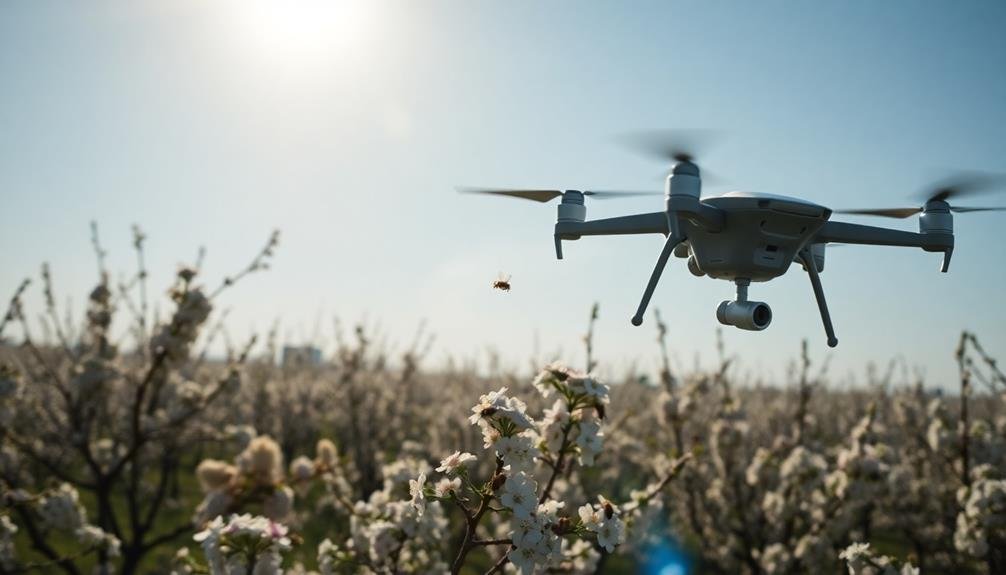
Unmanned aerial vehicles, commonly known as drones, have revolutionized agricultural practices, particularly in crop pollination. You’ll find these high-tech devices buzzing over fields, equipped with sensors and cameras to assess crop health and pollination needs. They’re capable of identifying areas where natural pollinators are scarce or ineffective, allowing for targeted interventions.
Drones can carry pollen-dispersing mechanisms, effectively supplementing or even replacing traditional insect pollinators in some cases. You’ll see them distributing pollen with precision, ensuring even coverage across large fields. This technology is especially valuable for crops that require cross-pollination or those grown in controlled environments where natural pollinators can’t access.
Moreover, drones provide real-time data on flowering patterns and pollination progress. You can use this information to optimize pollination timing and adjust your agricultural strategies accordingly.
They’re also helpful in monitoring pest populations that might interfere with pollination processes. By integrating drone technology into your farming practices, you’re likely to see improved crop yields, reduced labor costs, and more efficient use of resources.
It’s a game-changer for modern agriculture, offering solutions to pollination challenges in an era of declining natural pollinator populations.
Challenges in Drone Pollination Monitoring
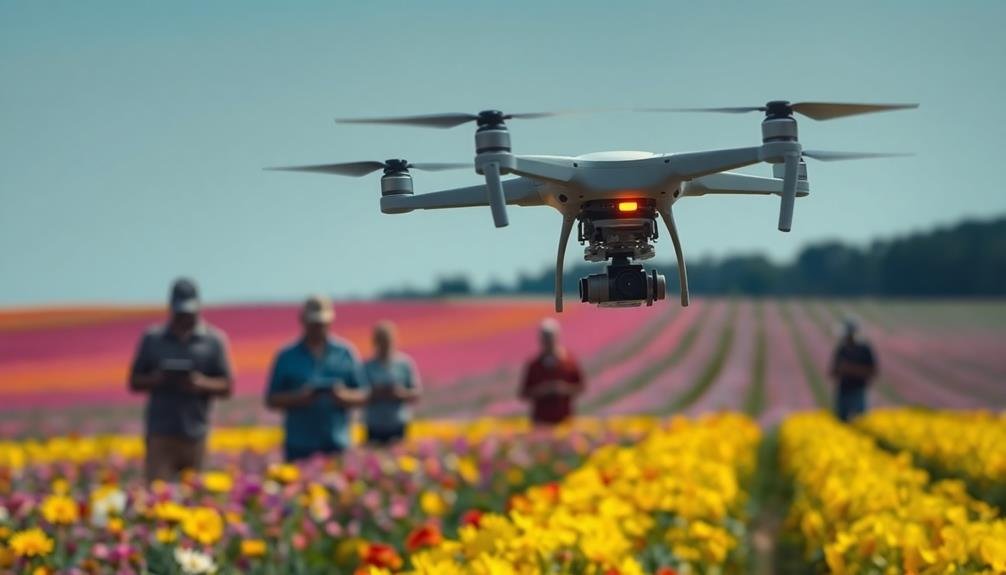
As you explore drone pollination monitoring, you’ll encounter several challenges.
You’ll need to address data accuracy issues, manage battery life limitations, and consider weather impact concerns.
These factors can greatly affect the reliability and effectiveness of your drone-based pollination monitoring efforts.
Data Accuracy Issues
While drone technology offers promising solutions for crop pollination monitoring, it faces significant hurdles in data accuracy. You’ll find that environmental factors like wind, temperature, and humidity can affect the drone’s sensors, leading to inconsistent readings.
Lighting conditions also play an essential role, as shadows or glare can interfere with image quality and pollen detection.
You’re likely to encounter issues with spatial resolution, as drones may struggle to capture minute details of pollen transfer between flowers. This limitation can result in underestimating or overestimating pollination rates.
Additionally, you’ll need to take into account the temporal resolution, as drones can’t continuously monitor fields, potentially missing critical pollination events.
Data interpretation poses another challenge. You’ll have to develop sophisticated algorithms to differentiate between pollen and other airborne particles.
Machine learning models must be trained on diverse datasets to accurately identify different pollen types and pollinator species.
You’ll also need to account for the three-dimensional nature of crop canopies, as traditional 2D imaging may not capture the full extent of pollination activity within the plant structure.
Battery Life Limitations
Despite recent advancements in drone technology, battery life remains a significant hurdle in effective crop pollination monitoring. You’ll find that most commercial drones can only stay airborne for 20-30 minutes before needing a recharge. This limited flight time restricts the area you can cover in a single session, potentially missing essential pollination events.
To overcome this challenge, you’ll need to plan your flights strategically. You might consider using multiple drones to cover larger areas or implementing a battery swap system to minimize downtime. However, these solutions can increase your operational costs and complexity.
Advances in battery technology are promising, but they’re not keeping pace with the demands of agricultural monitoring. You’ll need to balance the desire for longer flight times with the weight constraints of the drone. Heavier batteries mean less payload capacity for sensors and cameras.
As you plan your pollination monitoring strategy, factor in these battery limitations. You may need to prioritize specific areas or times of day for observation, ensuring you capture the most vital data within the available flight time.
Weather Impact Concerns
Weather conditions pose considerable challenges for drone-based pollination monitoring. You’ll find that wind, rain, and extreme temperatures can greatly impact drone performance and data accuracy. Strong winds may throw drones off course, affecting their ability to capture precise imagery or pollen samples.
Rain can interfere with sensors and cameras, potentially damaging equipment and reducing visibility. High temperatures can cause drones to overheat, limiting flight time and potentially damaging internal components. Conversely, cold weather can reduce battery efficiency, further shortening operational periods.
You’ll need to take these factors into account when planning monitoring schedules and interpreting collected data. Cloud cover and varying light conditions can also affect image quality and spectral analysis, potentially skewing results.
You’ll want to make sure your drones are equipped with appropriate weather-resistant features and that your data analysis accounts for these variables. To mitigate these concerns, you should implement robust weather monitoring systems, flexible scheduling, and redundant data collection methods.
Future of Tech-Driven Pollination Insights
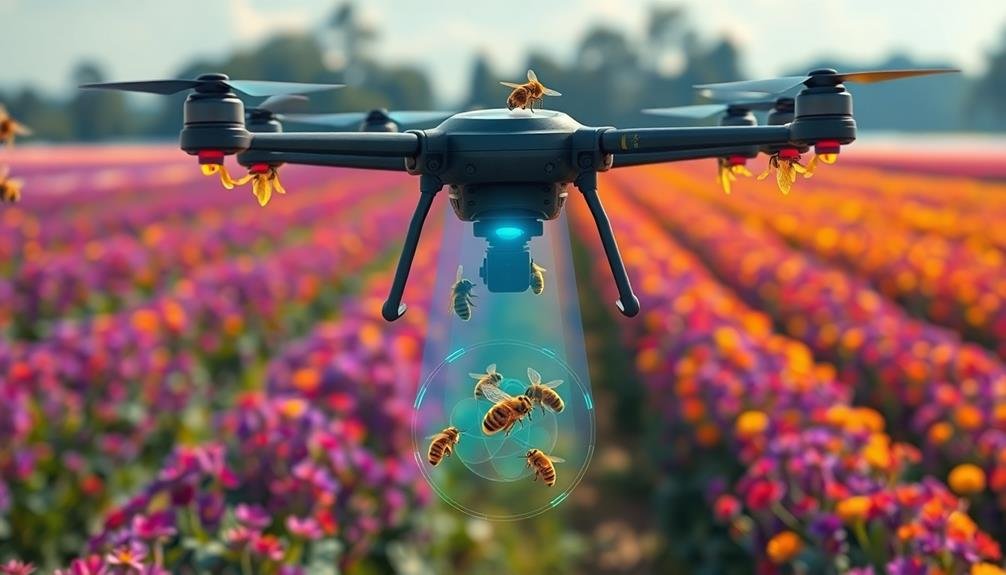
The crystal ball of agricultural technology reveals a promising future for tech-driven pollination insights.
You’ll see an integration of AI and machine learning algorithms that can predict ideal pollination times with unprecedented accuracy. These systems will analyze vast datasets, including historical weather patterns, crop cycles, and pollinator behavior, to provide real-time recommendations for farmers.
You can expect drones and autonomous robots to play a larger role in pollination monitoring. They’ll use advanced sensors and imaging technology to assess flower density, pollen viability, and insect activity across expansive fields. This data will help you make informed decisions about supplemental pollination or pest control measures.
IoT devices will become more prevalent, creating interconnected networks of sensors throughout your crops. These will continuously monitor environmental conditions, alerting you to potential issues before they impact pollination success.
Genetic sequencing and analysis tools will allow you to better understand the complex relationships between plants and pollinators. This knowledge will lead to the development of more resilient crop varieties and targeted conservation efforts for beneficial insects.
As these technologies evolve, you’ll witness a transformation in crop management practices, ultimately leading to increased yields and sustainability.
Environmental Impact of Drone Usage
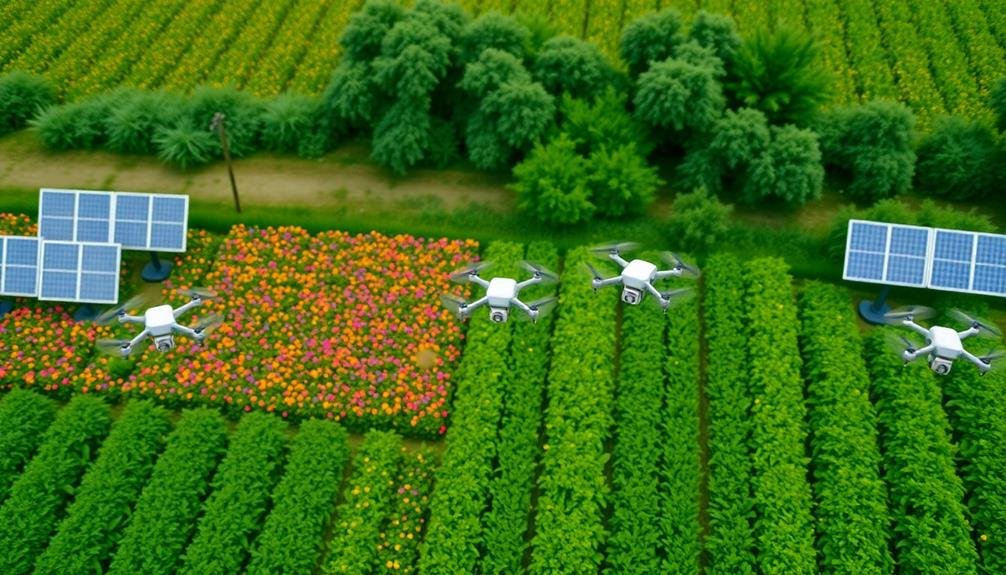
As you consider the environmental impact of drone usage in crop pollination, you’ll need to weigh several factors.
Energy consumption is a primary concern, as the increased use of drones could lead to higher electricity demands.
You should also be aware of potential noise pollution and wildlife disturbance issues, which could affect local ecosystems and animal behaviors.
Energy Consumption Concerns
While drones offer innovative solutions for crop pollination, their energy consumption raises environmental concerns. You’ll find that most agricultural drones rely on lithium-ion batteries, which require frequent charging and replacement. This dependency on electrical power can lead to increased energy demand, potentially straining local power grids in rural areas.
You should take into account the lifecycle of these batteries too. Their production and disposal contribute to environmental issues, including resource depletion and potential pollution.
As you explore drone pollination technology, you’ll notice efforts to improve energy efficiency through lightweight materials and optimized flight patterns.
You might also encounter emerging alternatives, such as solar-powered drones or those using hydrogen fuel cells. These technologies aim to reduce the carbon footprint associated with drone operations. However, they’re still in early development stages and face challenges regarding cost and practicality.
As you weigh the benefits of drone pollination against its energy consumption, you’ll need to take into consideration the broader environmental impact. This includes comparing drone energy use to traditional pollination methods and evaluating the overall sustainability of this technological approach to agriculture.
Noise Pollution Effects
Buzzing drones can create significant noise pollution, impacting both wildlife and nearby human communities.
You’ll find that the constant whirring of drone propellers disrupts natural soundscapes, potentially causing stress and behavioral changes in animals. Birds may alter their nesting patterns, while mammals might flee from their habitats, disrupting local ecosystems.
For humans living near agricultural areas, the noise can be a persistent nuisance. You might experience sleep disturbances, increased stress levels, and reduced quality of life. Children’s learning and cognitive development could also be affected by prolonged exposure to drone noise.
To mitigate these effects, you’ll need to take into account implementing noise reduction technologies in drone design. Quiet propellers, sound-dampening materials, and optimized flight patterns can help minimize the acoustic footprint of pollination drones.
You should also establish strict operational guidelines, limiting flight hours and maintaining minimum distances from residential areas.
It’s essential to balance the benefits of tech-driven crop pollination with the potential negative impacts on the environment and communities.
Wildlife Disturbance Potential
Beyond noise pollution, drones used for crop pollination can considerably impact wildlife behavior and ecosystems. You’ll find that these aerial devices may disrupt natural patterns and habitats in several ways. Birds, in particular, can be sensitive to drone presence, often perceiving them as threats. This can lead to increased stress levels, altered nesting behaviors, and even temporary abandonment of habitats.
Mammals aren’t immune to drone disturbances either. They may experience heightened anxiety or flee from areas where drones operate frequently. This displacement can affect feeding patterns, mating behaviors, and overall population dynamics.
Here’s a quick overview of potential wildlife disturbances:
| Animal Group | Short-term Effects | Long-term Consequences |
|---|---|---|
| Birds | Nest abandonment | Reduced breeding success |
| Mammals | Increased stress | Habitat shifts |
| Insects | Disorientation | Pollination disruptions |
To mitigate these impacts, you’ll need to implement careful flight planning and timing. Consider seasonal wildlife patterns, avoid known nesting areas, and limit drone operations during essential breeding periods. By balancing technological advancements with environmental consciousness, you can harness the benefits of drone pollination while minimizing ecological disruptions.
Frequently Asked Questions
How Do Drones Affect Natural Pollinator Behavior During Monitoring?
You’ll find that drones can disrupt natural pollinators during monitoring. They might scare off bees or butterflies with their noise and presence. However, if used carefully, drones can minimize interference while still gathering valuable data on pollination patterns.
What Are the Legal Restrictions for Using Drones in Agricultural Settings?
You’ll need to follow FAA regulations for drone use in agriculture. These include registering your drone, flying below 400 feet, keeping the drone in sight, and avoiding restricted airspace. Local laws may add additional restrictions.
Can Drone Technology Detect and Differentiate Between Various Pollinator Species?
Yes, you can use drone technology to detect and differentiate pollinator species. It’s equipped with high-resolution cameras and AI-powered image recognition software that’ll identify various insects. You’ll get accurate data on pollinator diversity and distribution in your fields.
How Does Weather Affect Drone-Assisted Pollination Monitoring Accuracy?
Weather greatly impacts your drone-assisted pollination monitoring. You’ll face reduced accuracy in windy conditions, rain, or extreme temperatures. Sunlight glare can affect image quality, while fog or mist may obscure your drone’s sensors. Always consider weather forecasts.
What Training Is Required for Farmers to Implement Drone-Assisted Pollination Monitoring?
You’ll need basic drone operation training and data interpretation skills. Learn about pollination biology, your specific crops, and how to use monitoring software. Attend workshops or online courses focused on agricultural drone applications and precision farming techniques.
In Summary
You’ve seen how drones are revolutionizing crop pollination monitoring. They’re providing valuable insights, improving yields, and helping farmers make data-driven decisions. While challenges exist, the future of tech-driven pollination looks promising. As you embrace this technology, remember to take into account its environmental impact. You’re part of an exciting shift in agriculture, where buzzing drones above your fields are becoming as common as the bees they’re helping to understand.

As educators and advocates for responsible drone use, we’re committed to sharing our knowledge and expertise with aspiring aerial photographers.




Leave a Reply